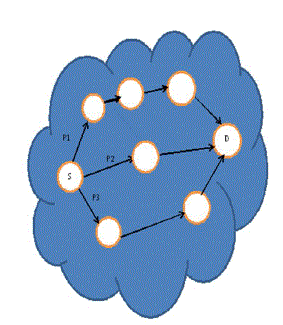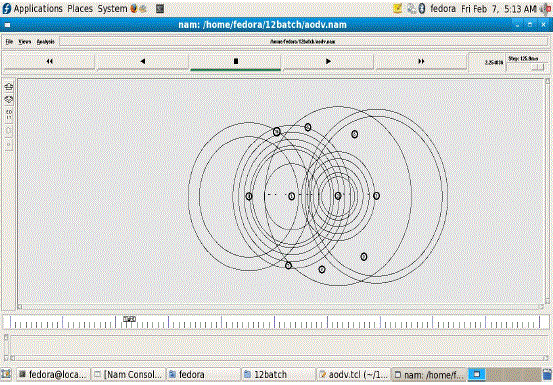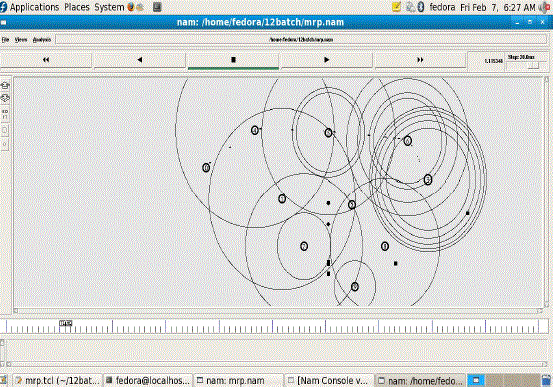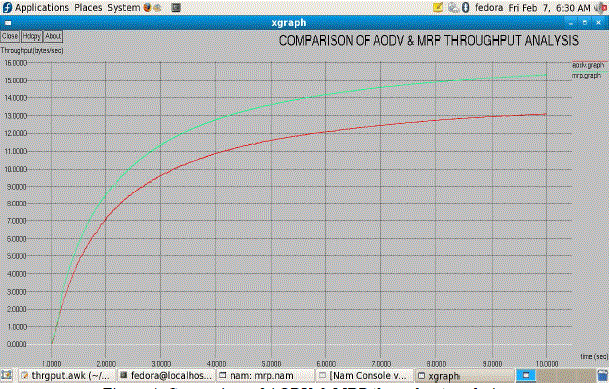Keywords
|
| MANET, AODV, MRP, Routing Protocol, Throughput |
INTRODUCTION
|
| A mobile ad hoc network (MANET) consists of a collection of wireless mobile nodes which dynamically exchange data among themselves without the reliance on a fixed base station or a wide backbone network. MANET nodes are typically distinguished by their limited power, processing, and memory resources as well as high degree of mobility. In such networks, the wireless mobile nodes may dynamically enter the network as well as leave the network. Due to the limited transmission range of wireless network nodes, multiple hops are usually needed for a node to exchange information with any other node in a network. Thus routing is a crucial issue to the design of a MANET. In this paper, we specifically examine the issues of multipath routing in MANETs. |
| Multipath routing allows the establishment of multiple paths between a single source and single destination node. It is typically proposed in order to increase the reliability of data transmission or to provide load balancing. Load balancing is of special importance in MANETs because of the limited bandwidth between the nodes. We also discuss the application of multipath routing to support application constraints such as reliability, load-balancing, energy-conservation, and Quality-of- Service (QoS). |
RELATED WORK
|
| Edward W. Knightly et.al.,[1] proposed that multi-hop networks, Packet schedulers at downstream nodes have an opportunity to make up for excessive latencies due to congestion at upstream nodes. Similarly, when packets incur low delays an upstream nodes .downstream nodes can reduce priority and schedule other packets first. The goal of this paper is to define a framework for design and analysis of Coordinated Network Scheduling(CNS) which exploit such inter-node coordination .We first provide a general CNS definition which enables us to classify a number of schedulers from the literature including, FIFO+ ,CEDF, and work-conserving CJVC as examples of CNS schedulers. We then develop a distributed theory of traffic envelopes which enables us to derive end-to-end statistical admission control conditions for CNS schedulers. |
| Chengzhi Li et al.,[2] proposed that multi-hop networks, packet schedulers at downstream nodes have an opportunity to make up for excessive latencies due to congestion at upstream nodes. Similarly, when packets incur low delays at upstream nodes, downstream nodes can reduce priority and schedule other packets first. The goal of this paper is to define a framework for design and analysis of Coordinated Multi-hop Scheduling (CMS) which exploit such inter-node coordination. Consequently, our technique exploits statistical resource sharing among flows, classes, and nodes, and our results provide the first statistical multimode multiclass admission control algorithm for networks of work conserving servers. |
| Mario Gerlaet.al.,[3] proposed that routing has been the most focused area in ad hoc networks research. On demand routing in particular, is widely developed in bandwidth constrained mobile wireless ad hoc networks because of its effectiveness and efficiency. Most proposed on-demand routing protocols however, build and rely on single route for each data session. Whenever there is a link disconnection on the active route, the routing protocol must perform a route recovery process. In routing for wired networks, multiple path routing is popularly used. Multiple routes are however, constructed using link state or distance vector algorithms which are not well suited for ad hoc networks. We propose an on-demand routing scheme called Split Multipath Routing (SMR) that establishes and utilizes multiple routes of maximally Disjoint paths. Providing multiple routes helps minimizing route recovery process and control message overhead. |
| Zygmunt J. Hass et.al.,[4] proposed that a framework for multipath routing in ad hoc networks and provide its analytical evaluation. The instability of the topology in these type of networks due to nodal mobility and changes in the wireless prorogation condition makes transmission on time sensitive information challenging problem.to combat this inherent unreliability of these networks, we propose a routing scheme uses multi-paths simultaneously by splitting the information among the multitude of paths. To increase the probability that the essential portion of the information is received at the destination without incurring excessive delay. |
| Stephen Mueller et.al., [5] proposed that Mobile ad hoc networks (MANETs) consist of a collection of wireless mobile nodes which dynamically exchange data among themselves without the reliance on a fixed base station or a wired backbone network. MANETs have potential use in a wide variety of disparate situations. Such situations include moving battlefield communications to disposable sensors which are dropped from high altitudes and dispersed on the ground for hazardous materials detection. MANET nodes are typically distinguished by their limited power, processing, and memory resources as well as high degree of mobility. Multipath routing allows the establishment of multiple paths between a single source and single destination node. It is typically proposed in orderto increase the reliability of data transmission or to provide load balancing. Load balancing is of especial importance in MANETs because of the limited bandwidth between the nodes. |
EXISTING ALGORITHM
|
| AODV is a packet routing protocol designed for use in mobile ad hoc networks (MANET).Intended for networks that may contain thousands of nodes. One of a class of demand-driven protocols the route discovery mechanism is invoked only if a route to a destination is not known, UDP is the transport layer protocol. Source, destination and next hop are addressed using IP addressing. Each node maintains a routing table that contains information about reaching destination nodes. Each entry is keyed to a destination node. The main advantage of this protocol is having routes established on demand and that destination sequence numbers are applied to find the latest route to the destination. The connection setup delay is lower. The main disadvantage of this protocol is that intermediate nodes can lead to inconsistent routes. Source sequence no is very old. More number of intermediate nodes. Unnecessary bandwidth consumption is to periodic beaconing. |
PROPOSED ALGORITHM
|
| Multipath Routing is the spreading of traffic from a source node to a destination node over multiple paths through the network. Multipath routing is a technique that exploits the underlying physical network resources by using multiple source destination paths. It is used for a number of purposes, including bandwidth aggregation, minimizing end-to-end delay, increasing fault-tolerance, enhancing reliability, load balancing and so on. The idea of using multiple paths has existed for some time and it has been explored in different areas of networking. It will select the multiple hop-path.It will maintain the topology. |
| Figure 1 shows that S denotes Source and D denotes Destination. From source to destination having three paths P1 , P2 & P3 to transmit the messages. MRP protocol it will select the multi-hop path. From this path, avoid the collision & decrease the delay. Using MRP protocol, topology can also maintain. If any node leaves/enters into the network, MRP protocol analyzes and informs to all the nodes in the network. The application of this protocol is used in mobile phones to avoid the collision by using this scheme. • It can be used in mobile phones to avoid the collision by using this scheme. |
| A. ALGORITHM |
| Here used the algorithm for multipath routing protocol using ad-hoc on demand routing protocol. |
| Step-1: Create a graph G(V,E): V€N, N --> Number of nodes |
| Step-2: Assigning a Source node from G(V,E): Assume V1€G(V) |
| Step-3: G(V1) --> Server, Detects the Path Using Control messages |
| Step-4: G(V1) sends P to Neighbouring nodes, V1 receives A {it will collect path information} |
| Step-5:V1 decides the path using routing information and then transmit the packets. |
| The above algorithm states, that the function of multipath routing protocol. It is used to increase the network performance and reduce the delay. |
SIMULATION RESULTS
|
| Experimental results were done by network simulator [NS] 2.32 version. It is implemented by two languages (C++, OTcl). The inputs are given and the 10 nodes were created. Simulation results were compared using two protocols.Node 0 is the source node; node 3 is a destination node. Node 0 uses intermediate nodes to transmit the packets. Ad hoc on - Demand Distance Vector Protocol is designed for using intermediate nodes in on - Demand. It does not create the routing table. It will directly select the path in on – Demand using intermediates. |
| Figure 2 shows that output of Ad hoc on Demand Distance Vector Protocol. Here node 0 transmit the packets to node 3 using intermediate nodes. |
| Figure 3 shows that output of Multipath Routing Protocol. Here also node 0 is the source node, node 3 is the destination node. In this protocol, used to select the multi hop path between source to destination. Between node 0 (source node ) and node 3 ( destination ) it contains three paths. Each path contains different number of hops. Multipath Routing Protocol is mainly designed for used to select the multiple hops. Source node ( node 0) will search the path after that it will design which paths contains more number of hops between the source and destination. Source node selects the more number of hops path and also transmit the packets. |
| Figure 4 shows that comparison of Ad hoc on Demand Distance Vector Protocol and Multipath Routing Protocol. Throughput is defined as the total number of packets delivered over the total simulation time (Tp = N/ts). Multipath Routing Protocol has high throughput compare to Ad hoc on - Demand Distance Vector Protocol and Multipath Routing Protocol. Because Multipath Routing Protocol selects the more number of hops path between source and destination to reach the packets earlier from this Multipath Routing Protocol can able to increase the packet delivery rate compare to AODV, MRP protocol received more number of packets with respect to time. |
CONCLUSION AND FUTURE WORK
|
| Nowadays in today’s world using wireless network, from that facing many difficulties due to mobility. In existing system used an AODV (Ad hoc on Demand Distance Vector Protocol) routing protocol. AODV routing protocol overcome the DVR drawbacks but the transmission delay is higher. To overcome all the difficulties, implemented a new technique called multipath routing protocol. From this technique can reduce the delay, increase the throughput and network. Simulation results were compared the AODV routing protocol and MRP routing protocol. Results were shown that MRP protocol has high throughput and lesser delay compared to AODV routing protocol. |
Figures at a glance
|
 |
 |
 |
 |
| Figure 1 |
Figure 2 |
Figure 3 |
Figure 4 |
|
| |
References
|
- M. Andrews, “Probabilistic end-to-end delay bounds for earliest deadline first scheduling,” in Proc. IEEE INFOCOM 2000, Tel Aviv, Israel,Mar.2000, pp. 603–612.
- R. Burstyn, A. Bur chard, J. Liebeherr, and C. Oottamakorn. Tradeoffs in networks with end-to-end statistical QoS guarantees. In Proceedings ofIWQoS 2000, June 2000.
- Marina, M.K., Das, S.R.: On-demand Multipath Distance Vector Routing in Ad Hoc Networks. Proceedings of the International Conference forNetwork Procotols (2001)
- J. Broch, D.A. Malts, D.B. Johnson, Y.-C. Hu, and J. Jetcheva, .A Performance Comparison of Multi-Hop Wireless Ad Hoc Network RoutingProtocols,.Proceedings of ACM/IEEE MOBICOM'98, Dallas, TX, Oct. 1998, pp. 85-97.
- Stephen Mueller, Rose P. Tsang, DipakGhosal“ Multipath Routing in Mobile Ad Hoc Networks: Issues and Challenges” Lecture Notes in ComputerScience, Volume 2965, Pages. 209 – 234, 2004.
- Michael Voorhaen, Chris Blondia, Analyzing the Impact of Neighbor Sensing on the Performance of the OLSR protocol,Modeling and Optimizationin Mobile, Ad Hoc and Wireless Networks, 2006 4th International Symposium on0306 April 2006Page(s):1 6
- Chengzhi Li, Knightly, E.W. Coordinated network scheduling: a framework for end-to-end services. Network Protocols,2000. Proceedings. 2000International Conference on, 14-17 Nov. 2000, pp69
- J. Parker, J. Undercoffer, J.Pinkston, and A.Joshi, “On instruction detection and response for mobile ad hoc networks,” in Proc. IEEE Int. Conf.perfom.,Comput., Commun., 2004, pp.747-752.
- G. Jayakumar and G. Gopinath, “Ad hoc mobile wireless networks rout-ing protocol- A review ,” J. Comput. Sci., vol. 3, no.8, pp. 574-582, 2007.
- Anantvalee . T and J. Wu, “A Survey on Instruction Detection in Mobile Ad Hoc Networks,” in wireless/mobile security. New york: Springer-Verlag, 2008.
- Rohit A. Talwalker Mohammad Ilyas, “Analysis of Quality of Service (QoS) in WiMax Networks,” ICON IEEE 2008, 12-14 Dec. 2008, pp. 1-8.
- Nor SurayatiMohamadUsop, Azizol Abdullah, Ahmad Faisal AmriAbidin. Performance Evalution of Environment. IJCSNS, VOL.9 NO.7, pp 261-268 july 2009.
- R. Al-Ani, “Simulation and Performance analysis evalution for variant MANET routing protocols1,”International journal of Advancements inComputing technology, Volume 3, Number 1, Februry 2011.
|